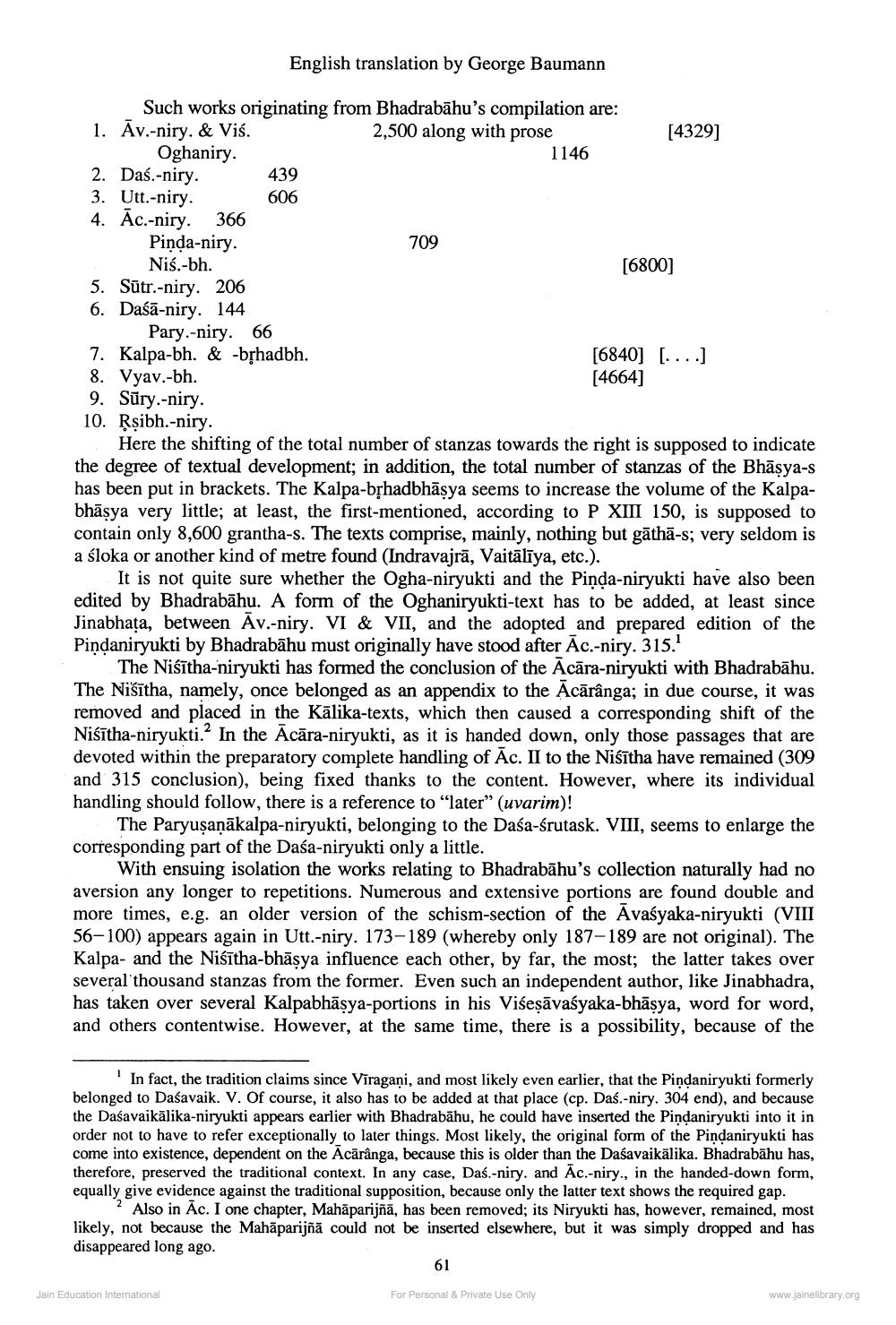________________
English translation by George Baumann
439
Such works originating from Bhadrabāhu's compilation are: 1. Av.-niry. & Vis. 2,500 along with prose
[4329] Oghaniry.
1146 2. Das.-niry. 3. Utt.-niry. 606 4. Ac.-niry. 366 Pinda-niry.
709 Nis.-bh.
[6800] 5. Sūtr.-niry. 206 6. Daśā-niry. 144
Pary.-niry. 66 7. Kalpa-bh. & -brhadbh.
[6840] [....] 8. Vyav.-bh.
(4664] 9. Sūry.-niry. 10. Rşibh.-niry.
Here the shifting of the total number of stanzas towards the right is supposed to indicate the degree of textual development; in addition, the total number of stanzas of the Bhāsya-s has been put in brackets. The Kalpa-bhadbhāsya seems to increase the volume of the Kalpabhāsya very little; at least, the first-mentioned, according to P XIII 150, is supposed to contain only 8,600 grantha-s. The texts comprise, mainly, nothing but gāthā-s; very seldom is a śloka or another kind of metre found (Indravajrā, Vaitālīya, etc.).
It is not quite sure whether the Ogha-niryukti and the Pinda-niryukti have also been edited by Bhadrabāhu. A form of the Oghaniryukti-text has to be added, at least since Jinabhata, between Av.-niry. VI & VII, and the adopted and prepared edition of the Pindaniryukti by Bhadrabāhu must originally have stood after .c.-niry. 315.
The Niśītha-niryukti has formed the conclusion of the Acāra-niryukti with Bhadrabāhu. The Niśītha, namely, once belonged as an appendix to the Acārânga; in due course, it was removed and placed in the Kālika-texts, which then caused a corresponding shift of the Nisītha-niryukti.? In the Acāra-niryukti, as it is handed down, only those passages that are devoted within the preparatory complete handling of Ac. II to the Niśītha have remained (309 and 315 conclusion), being fixed thanks to the content. However, where its individual handling should follow, there is a reference to "later" (uvarim)!
The Paryusanākalpa-niryukti, belonging to the Daśa-śrutask. VIII, seems to enlarge the corresponding part of the Dasa-niryukti only a little.
With ensuing isolation the works relating to Bhadrabāhu's collection naturally had no aversion any longer to repetitions. Numerous and extensive portions are found double and more times, e.g. an older version of the schism-section of the Avaśyaka-niryukti (VIII 56-100) appears again in Utt.-niry. 173-189 (whereby only 187-189 are not original). The Kalpa- and the Niśītha-bhāsya influence each other, by far, the most; the latter takes over several thousand stanzas from the former. Even such an independent author, like Jinabhadra, has taken over several Kalpabhāsya-portions in his Višeşāvasyaka-bhāsya, word for word, and others contentwise. However, at the same time, there is a possibility, because of the
In fact, the tradition claims since Vīragani, and most likely even earlier, that the Pindaniryukti formerly belonged to Daśavaik. V. Of course, it also has to be added at that place (cp. Das.-niry. 304 end), and because the Daśavaikālika-niryukti appears earlier with Bhadrabāhu, he could have inserted the Pindaniryukti into it in order not to have to refer exceptionally to later things. Most likely, the original form of the Pindaniryukti has come into existence, dependent on the Acārânga, because this is older than the Daśavaikālika. Bhadrabāhu has, therefore, preserved the traditional context. In any case, Das.-niry. and Ac.-niry., in the handed-down form, equally give evidence against the traditional supposition, because only the latter text shows the required gap.
4 Also in Ac. I one chapter, Mahāparijñā, has been removed; its Niryukti has, however, remained, most likely, not because the Mahāparijñā could not be inserted elsewhere, but it was simply dropped and has disappeared long ago.
61
Jain Education International
For Personal & Private Use Only
www.jainelibrary.org




